#Michele Cocchi
Text
I vincitori del PLUS - Premio Letterario Fondazione Uspidalet – Alessandria Cultura 2022
I vincitori del PLUS – Premio Letterario Fondazione Uspidalet – Alessandria Cultura 2022
I vincitori del PLUS – Premio Letterario Fondazione Uspidalet – Alessandria Cultura 2022
Michele Cocchi per la narrativa edita, Assia Petricelli e Sergio Riccardi per la sezione graphic novel e Riccado Fagoni per narrativa inedita si aggiudicano il riconoscimento dedicato al mondo dell’adolescenza
A Palazzo Monferrato ad Alessandria sono stati annunciati sono stati annunciati i vincitori del…
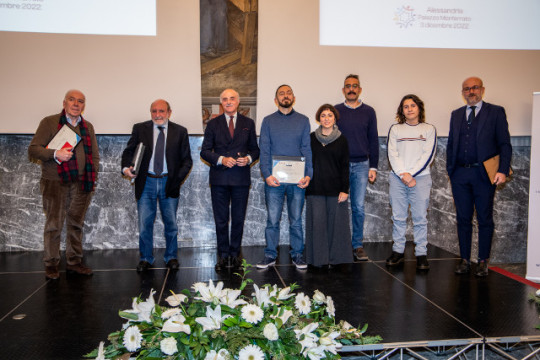
View On WordPress
#Alessandria Cultura 2022#Alessio Pini Prato#Assia Petricelli#Bruno Lulani#Michele Cocchi#Premio Letterario Fondazione Uspidalet#Riccardo Fagoni#Sergio Riccardi#Umberto Galimberti#vincitori PLUS 2022#Walter Fochesato
1 note
·
View note
Text
Neophron percnopterus
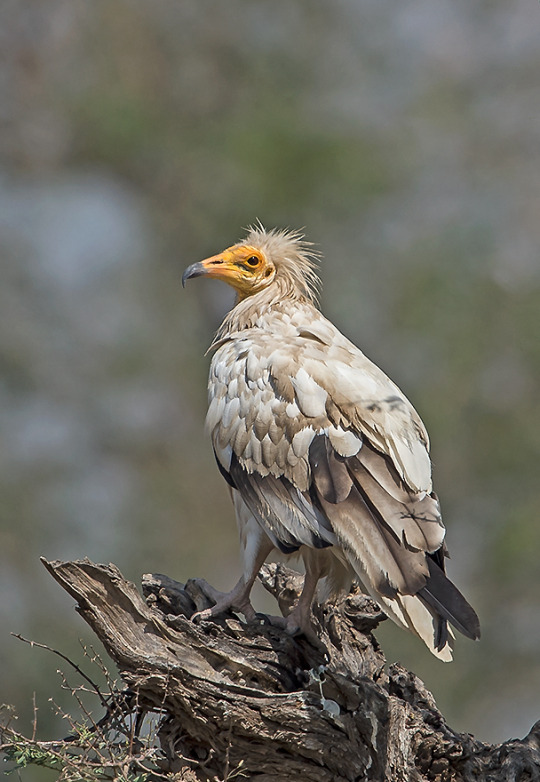
By Koshy Koshy, CC BY 2.0
Etymology: A Childish Trickster
First Described By: Savigny, 1809
Classification: Dinosauromorpha, Dinosauriformes, Dracohors, Dinosauria, Saurischia, Eusaurischia, Theropoda, Neotheropoda, Averostra, Tetanurae, Orionides, Avetheropoda, Coelurosauria, Tyrannoraptora, Maniraptoromorpha, Maniraptoriformes, Maniraptora, Pennaraptora, Paraves, Eumaniraptora, Averaptora, Avialae, Euavialae, Avebrevicauda, Pygostaylia, Ornithothoraces, Euornithes, Ornithuromorpha, Ornithurae, Neornithes, Neognathae, Neoaves, Inopinaves, Telluraves, Afroaves, Accipitrimorphae, Accipitriformes, Accipitridae, Gypaetinae
Status: Extant, Endangered
Time and Place: Since 12,000 years ago, in the Holocene of the Quaternary

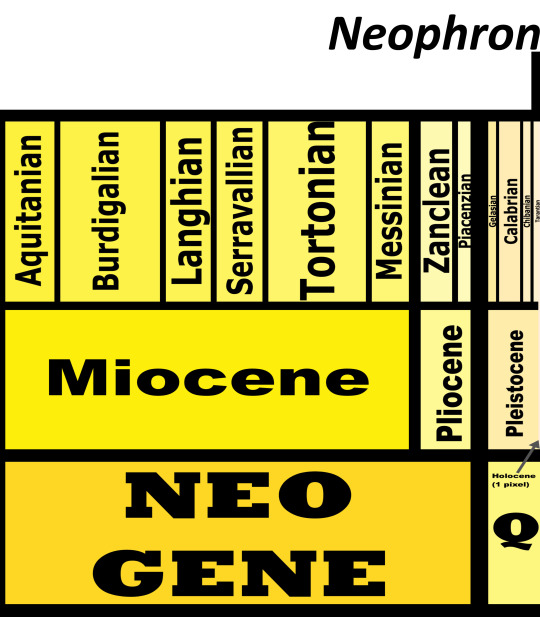
Egyptian Vultures are known from locations across India, Western Asia, Africa, and Southern Europe

Physical Description: The Egyptian Vulture is a small vulture, only about 54 to 70 centimeters long with a wingspan of a little more than twice that size. It is also very distinctive in color, and extremely fluffy (which makes sense, given it is probably closely related to the Bearded Vulture). It has a very long and narrow head, which is bare and yellow over the eyes and beak; the tip of the beak is sharply hooked and black. The back of the head and neck is very fluffy and white. The rest of the body is also very puffed, mostly white but with black edges and tips to the wing feathers and tail feathers. It has white fluffy legs, with only some of the feet bear; the feet are pale in color. The females are usually much heavier than the males. The juveniles are significantly darker than the adults in color.
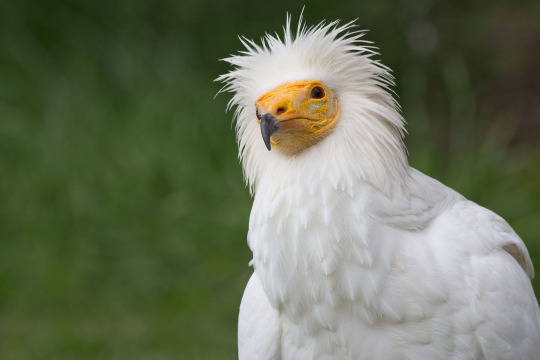
By Carlos Delgado, CC BY-SA 3.0
Diet: Egyptian Vultures primarily feed on large dead animals such as carrion of birds, livestock, wild mammals, and even dogs. Usually it will prefer scraps from large carcasses. Sometimes it will also eat eggs!
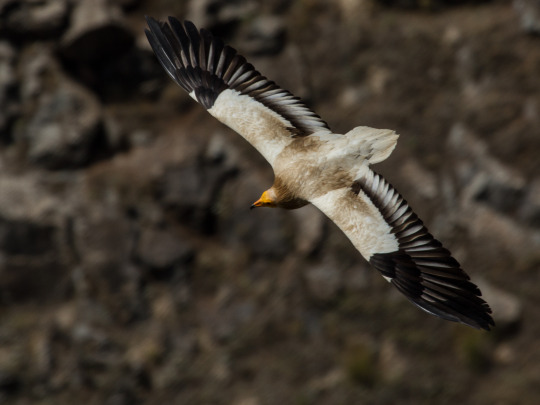
By Вых Пыхманн, CC By-SA 3.0
Behavior: These vultures are pragmatic opportunists, eating a wide variety of carrion that are often rejected by other vulture. It even competes often with crows and other corvids - more pragmatic, intelligent birds! These vultures spend a lot of the day soaring overhead, searching for food from up to one kilometer away; they also will perch and search for food on trees and cliffs. They tend to congregate in large numbers where there is good sources of food - even though this bird is rare. They will pull off chunks of carcass and often will throw stones at eggs to open them up - a documented use of tools! They also will use twigs to roll up and gather strands of wool for nest-lining. They aren’t very loud birds, making small whistles, grunts, groans, and hisses when needed. Somewhat social birds, they are usually found in pairs or in large groups around carcasses, though often they spend time alone.
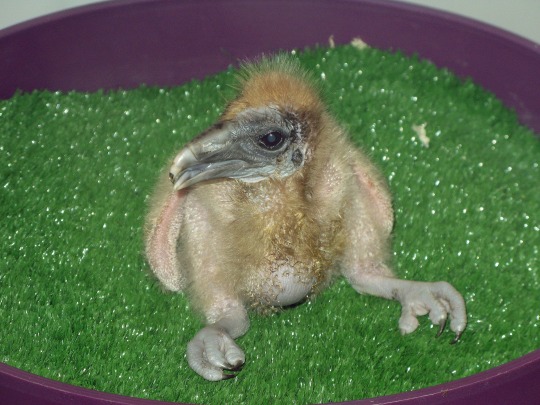
By Jiel, CC BY-SA 4.0
Egyptian Vultures breed in the spring, with pairs courting by soaring high together and then swooping and spiraling down. They are monogamous for at least one breeding season, and may stay with the same mate for many years or even their whole lives. They tend to come back to the same nest sites year after year. They make nests out of twigs and wool, placed on cliff ledges and on large tree forks. Neighboring birds may form polyamorous groups with a mated pair, allowing for the two pairs of adults to aid each other in caring for the young. Usually the birds prepare for copulation by giving each other food, and preening each other to get in the “mood”. They lay around two eggs usually, which are incubated for around one and a half months. All adults will incubate the chicks, which are very brown and puffy. They stay in the nest for up to three months, cared for by the parents for most of that time. They reach sexual maturity between 4 and 6 years of age, and can live for nearly four decades, though most tend to die by the fifth year of life in the wild.
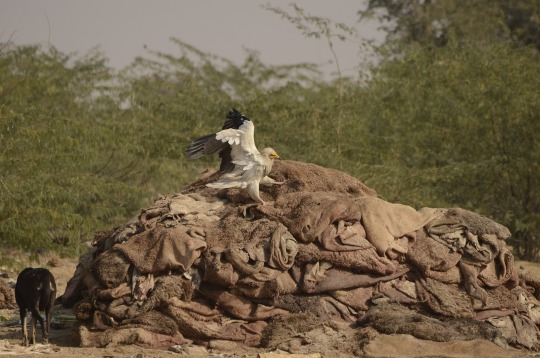
By PJeganathan, CC BY-SA 4.0
The vultures tend to soar on thermal wind, using the heat to raise themselves higher in the air; on the land they’re much less graceful, waddling around awkwardly. They are very calculating animals, waiting for predators to leave a carcass before approaching. They’ll even feed on poop to get carotenoids - pigments - from large herbivorous mammals. They tend to migrate only in the northern part of their range - in Africa and India, they stay mainly in the same location year-round. They glide extensively while flying, wasting as little energy while migrating as possible.
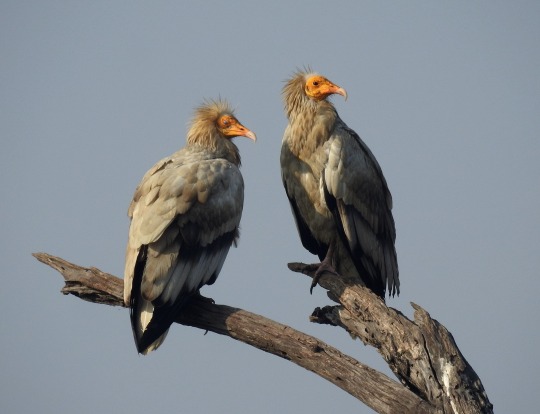
By Dr. Raju Kasambe, CC BY-SA 4.0
Ecosystem: Egyptian Vultures prefer open areas, preferably ones with dry and arid habitat. They especially prefer locations near cold and wet climates, such as scrub habitats. They also frequent deserts, steppes, pastures, and some fields, though they try to stay near rocky places when nesting. They also can be found in mountainous regions at lower or mid-level altitudes. They are hunted upon by golden eagles, eagle owls, and red foxes as young; they also are very vulnerable to other mammalian predators (like wolves) as adults and to human interference. In fact, human activity takes a toll on population size.
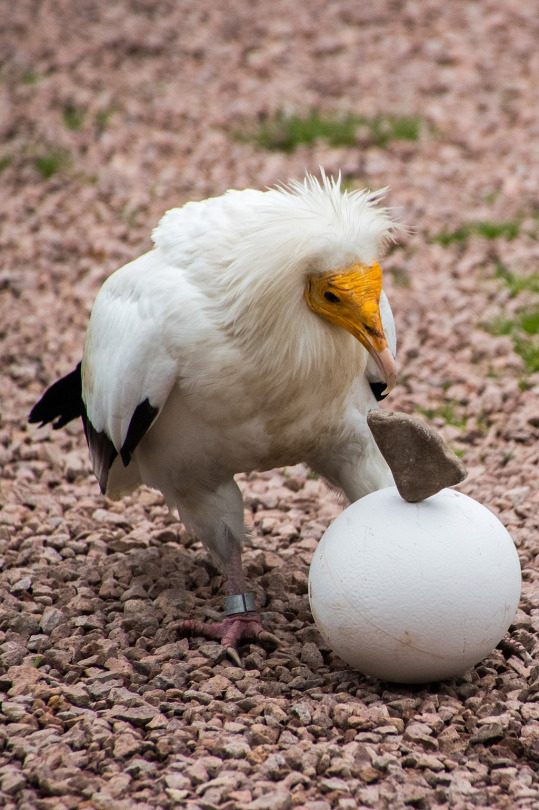
By Tomasz Baranowski, CC BY 2.0
Other: Egyptian Vultures have gone through extensive population decline, though in some locations the population is more stable now and recovering. They are greatly affected by human activity, including things such as power lines and hunting, intentional poisoning, and superstition-based activity. Since vultures are considered harbingers of doom, people tend to be afraid of them - and they aren’t always the prettiest birds, so people don’t feel emotional attachment to them enough to avoid killing them. Declines in herding and livestock maintenance among humans also has lead to some population decline. Combinations of these factors in many countries make conservation efforts difficult to implement. Some attempts to preserve this vulture have included “vulture restaurants”, where carcasses are made available to vultures nearby.
~ By Meig Dickson
Sources Under the Cut
Agarwal, G.P.; Ahmad, Aftab; Arya, Gaurav; Saxena, Renu; Nisar, Arjumand; Saxena, A.K. (2012). "Chaetotaxy of three nymphal instars of an ischnoceran louse, Aegypoecus perspicuus (Phthiraptera: Insecta)". Journal of Applied and Natural Science. 4 (1): 92–95.
Agostini, Nicolantonio; Premuda, Guido; Mellone, Ugo; Panuccio, Michele; Logozzo, Daniela; Bassi, Enrico; Cocchi, Leonardo (2004). "Crossing the sea en route to Africa: Autumn migration of some Accipitriformes over two Central Mediterranean islands". The Ring. 26 (2): 71–78.
Agudo, Rosa; Rico, Ciro; Vilà, Carles; Hiraldo, Fernando; Donázar, José (2010). "The role of humans in the diversification of a threatened island raptor". BMC Evolutionary Biology. 10: 384.
Ali, Sálim; Ripley, Sidney Dillon (1978). Handbook of the birds of India and Pakistan. Volume 1 (2nd ed.). Oxford University Press. pp. 310–314.
Amadon, D. 1977. Notes on the taxonomy of vultures. Condor 79(4):413-416
Amezian, M.; El Khamlichi, K. (2016). "Significant population of Egyptian Vulture Neophron percnopterus found in Morocco". Ostrich. 87 (1): 73–76.
Angelov, Ivaylo; Hashim, Ibrahim; Oppel, Steffen (2012). "Persistent electrocution mortality of Egyptian Vultures Neophron percnopterus over 28 years in East Africa". Bird Conservation International. 23: 1–6.
Baker, E.C. Stuart (1928). The Fauna of British India. Birds. Volume 5 (2nd ed.). London: Taylor and Francis. pp. 22–24.
Baxter, R. M.; Urban, E. K.; Brown, L. H (1969). "A Nineteenth-century reference to the use of tools by the Egyptian vulture". Journal of the East Africa Natural History Society and National Museum. 27 (3): 231–232.
Biddulph, C.H. (1937). "Unusual site for the nest of the White Scavenger Vulture Neophron percnopterus ginginianus (Lath.)". The Journal of the Bombay Natural History Society. 39 (3): 635–636.
Byrd, Brooke. "Of Love and Loathing: The Role of the Vulture in Three Cultures". Prized Writing: 81–93.
Carrete, Martina; Sánchez-Zapata, José A.; Benítez, José R.; Lobón, Manuel; Donázar, José A. (2009). "Large scale risk-assessment of wind-farms on population viability of a globally endangered long-lived raptor". Biological Conservation. 142 (12): 2954–2961.
Ceballos, Olga; Donázar, José Antonio (1990). "Roost-tree characteristics, food habits and seasonal abundance of roosting Egyptian Vultures in northern Spain". Journal of Raptor Research. 24 (1–2): 19–25.
Ceballos, Olga; Donázar, José Antonio (1989). "Factors influencing the breeding density and nest-site selection of Egyptian vulture (Neophron percnopterus)". Journal of Ornithology. 130 (3): 353–359.
Clark, William S.; Schmitt, N.J. (1998). "Ageing Egyptian Vultures". Alula. 4: 122–127.
Clements, J. F., T. S. Schulenberg, M. J. Iliff, D. Roberson, T. A. Fredericks, B. L. Sullivan, and C. L. Wood. 2017. The eBird/Clements checklist of birds of the world: v2017
Cortés-Avizanda, A.; Carrete, M.; Serrano, D.; Donázar, J.A. (2009). "Carcasses increase the probability of predation of ground-nesting birds: a caveat regarding the conservation value of vulture restaurants”. Animal Conservation. 12: 85–88.
Cortés-Avizanda, Ainara; Ceballos, Olga; Donázar, José A. (2009). "Long-Term Trends in Population Size and Breeding Success in the Egyptian Vulture (Neophron percnopterus) in Northern Spain". Journal of Raptor Research. 43 (1): 43–49.
Coultas, Harland (1876). Zoology of the Bible. London: Wesleyan Conference Office.
Cuthbert, R.; Green, R.E.; Ranade, S.; Saravanan, S.; Pain, D.J.; Prakash, V.; Cunningham, A.A. (2006). "Rapid population declines of Egyptian vulture (Neophron percnopterus) and red-headed vulture (Sarcogyps calvus) in India". Animal Conservation. 9 (3): 349–354.
Dewar, Douglas (1906). Bombay Ducks. John Lane, London. p. 277.
Donázar, José Antonio; Ceballos, Olga (1989). "Growth rates of nestling Egyptian Vultures Neophron percnopterus in relation to brood size, hatching order and environmental factors". Ardea. 77 (2): 217–226.
Donázar, Jose A.; Ceballos, Olga (1988). "Red fox predation on fledgling Egyptian vultures". Journal of Raptor Research. 22 (3): 88.
Donázar, José Antonio; Ceballos, Olga (1989). "Post-fledging dependence period and development of flight and foraging behaviour in the Egyptian Vulture Neophron percnopterus". Ardea. 78 (3): 387–394.
Donázar, José A.; Ceballos, Olga (1990). "Acquisition of food by fledgling Egyptian Vultures Neophron percnopterus by nest-switching and acceptance by foster adults". Ibis. 132 (4): 603–607.
Donázar, José A.; Ceballos, Olga; Tella, José L. (1994). "Copulation behaviour in the Egyptian Vulture Neophron percnopterus". Bird Study. 41 (1): 37–41.
Donázar, José A.; Ceballos, Olga; Tella, José L. (1996). "Communal roosts of Egyptian vultures (Neophron percnopterus): dynamics and implications for the species conservation". In Muntaner, J. (ed.). Biology and Conservation of Mediterranean Raptors. Monografía SEO-BirdLife, Madrid. pp. 189–201.
Donázar, José A.; Palacios, César J.; Gangoso, Laura; Ceballos, Olga; González, Maria J.; Hiraldo, Fernando (2002). "Conservation status and limiting factors in the endangered population of Egyptian vulture (Neophron percnopterus) in the Canary Islands". Biological Conservation. 107 (1): 89–97.
Donázar, José Antonio; Negro, Juan José; Palacios, César Javier; Gangoso, Laura; Godoy, José Antonio; Ceballos, Olga; Hiraldo, Fernando; Capote, Nieves (2002). "Description of a new subspecies of the Egyptian Vulture (Accipitridae: Neophron percnopterus) from the Canary Islands". Journal of Raptor Research. 36 (1): 17–23.
Elorriaga, Javier; Zuberogoitia, Iñigo; Castillo, Iñaki; Azkona, Ainara; Hidalgo, Sonia; Astorkia, Lander; Ruiz-Moneo, Fernando; Iraeta, Agurtzane (2009). "First Documented Case of Long-Distance Dispersal in the Egyptian Vulture (Neophron percnopterus)". Journal of Raptor Research. 43 (2): 142–145.
Ferguson-Lees, James; Christie, David A. (2001). Raptors of the World. Christopher Helm. pp. 417–420.
Galushin, V.M. (1975). "A comparative analysis of the density of predatory birds in two selected areas within the Palaearctic and Oriental regions, near Moscow and Delhi (IOC Abstracts)". Emu. 74 (5): 331.
Galushin, V. M. (2001). "Populations of vultures and other raptors in Delhi and neighboring areas from 1970's to 1990's". In Parry-Jones, J.; Katzner, T. (eds.). Report from the Workshop on Indian Gyps vultures: 4th Eurasian congress on raptors. Sevilla, Spain: aviary.org. pp. 13–15.
Gangoso, Laura (2005). "Ground nesting by Egyptian Vultures (Neophron percnopterus) in the Canary Islands". Journal of Raptor Research. 39 (2): 186–187.
Gangoso, Laura; Álvarez-Lloret, Pedro; Rodríguez-Navarro, Alejandro A. B.; Mateo, Rafael; Hiraldo, Fernando; Donázar, José Antonio (2009). "Long-term effects of lead poisoning on bone mineralization in vultures exposed to ammunition sources". Environmental Pollution. 157 (2): 569–574.
García-Ripollés, Clara; López-López, Pascual (2006). Penteriani, Vincenzo (ed.). "Population size and breeding performance of Egyptian vultures (Neophron percnopterus) in eastern Iberian Peninsula". Journal of Raptor Research. 40 (3): 217–221.
García-Ripollés, Clara; López-López, Pascual; Urios, Vicente (2010). "First description of migration and wintering of adult Egyptian Vultures Neophron percnopterus tracked by GPS satellite telemetry". Bird Study. 57 (2): 261–265.
Grande, Juan M.; Serrano, David; Tavecchia, Giacomo; Carrete, Martina; Ceballos, Olga; Díaz-Delgado, Ricardo; Tella, José L.; Donázar, José A. (2009). "Survival in a long-lived territorial migrant: effects of life-history traits and ecological conditions in wintering and breeding areas". Oikos. 118 (4): 580–590.
Grimal, Pierre (1996). The dictionary of classical mythology. Wiley-Blackwell. p. 18.
Hartert, Ernst (1920). Die Vögel der paläarktischen Fauna. Volume 2. Berlin: Friendlander & Sohn. pp. 1200–1202.
Hernández, Mauro; Margalida, Antoni (2009). "Poison-related mortality effects in the endangered Egyptian vulture (Neophron percnopterus) population in Spain". European Journal of Wildlife Research. 55 (4): 415–423.
Hertel, Fritz (1995). "Ecomorphological indicators of feeding behavior in recent and fossil raptors". The Auk. 112 (4): 890–903.
Hidalgo, S.; Zabala, J.; Zubergoitia, I.; Azkona, A.; Castillo, I. (2005). "Food of the Egyptian vulture (Neophron percnopterus) in Biscay". Buteo. 14: 23–29.
Ingerson, Ernest (1923). Birds in legend, fable and folklore. New York: Longmans, Green and Co.
Jardine, William; Selby, Prideaux John (1826). Illustrations of ornithology. Volume 1. Edinburgh: W.H. Lizars.
Jaume, D., M. McMinn, and J. A. Alcover. 1993. Fossil birds from the Bujero del Silo, La Gomera (Canary Islands), with a description of a new species of quail (Galliformes: Phasianidae). Boletim do Museu Municipal do Funchal 2:147-165
Jobling, J. A. 2010. The Helm Dictionary of Scientific Bird Names. Christopher Helm Publishing, A&C Black Publishers Ltd, London.
Koenig, Alexander (1907). "Die Geier Aegyptens" [The Egyptian vulture]. Journal für Ornithologie (in German). 55: 59–134.
Kretzmann, Maria B.; Capote, N.; Gautschi, B.; Godoy, J.A.; Donázar, J.A.; Negro, J.J. (2003). "Genetically distinct island populations of the Egyptian vulture (Neophron percnopterus)". Conservation Genetics. 4 (6): 697–706.
Latham, John (1787). Supplement to the General Synopsis of birds. London: Leigh & Sotheby. p. 7.
Liberatori, Fabio; Penteriani, Vincenzo (2001). "A long-term analysis of the declining population of the Egyptian vulture in the Italian peninsula: distribution, habitat preference, productivity and conservation implications". Biological Conservation. 101 (3): 381–389.
Linnaeus, C. 1758. Systema Naturae per Regna Tria Naturae, Secundum Classes, Ordines, Genera, Species, cum Characteribus, Differentiis, Synonymis, Locis. Editio Decima 1:1-824
Margalida, A.; Benítez, J.R.; Sánchez-Zapata, J.A.; Ávila, E.; Arenas, R.; Donázar, J.A. (2012). "Long-term relationship between diet breadth and breeding success in a declining population of Egyptian Vultures Neophron percnopterus". Ibis. 154: 184–188.
Margalida, Antoni; Boudet, Jennifer (2003). "Dynamics and temporal variation in age structure at a communal roost of egyptian vultures (Neophron percnopterus) in northeastern Spain". Journal of Raptor Research. 37 (3): 252–256.
Peters, James L. (1979). Mayr, Ernst; Cottrell, G.W. (eds.). Check-list of birds of the world. Volume 1 (2nd ed.). Cambridge, Massachusetts: Museum of Comparative Zoology. p. 304.
Mateo, Patricia; Olea, Pedro P. (2007). "Egyptian Vultures (Neophron percnopterus) Attack Golden Eagles (Aquila chrysaetos) to Defend their Fledgling". Journal of Raptor Research. 41 (4): 339–340.
Meyburg, Bernd-U.; Gallardo, Max; Meyburg, Christiane; Dimitrova, Elena (2004). "Migrations and sojourn in Africa of Egyptian vultures (Neophron percnopterus) tracked by satellite". Journal of Ornithology. 145 (4): 273–280.
Mundy, P.J. (1978). "The Egyptian vulture (Neophron Percnopterus) in Southern Africa". Biological Conservation. 14 (4): 307–315.
Neelakantan, K.K. (1977). "The sacred birds of Thirukkalukundram". Newsletter for Birdwatchers. 17 (4): 6.
Negro, J.J.; Grande, J.M.; Tella, J.L.; Garrido, J.; Hornero, D.; Donázar, J.A.; Sanchez-Zapata, J.A.; Benítez, J.R.; Barcell, M. (2002). "Coprophagy: An unusual source of essential carotenoids". Nature. 416 (6883): 807–808.
Orta, J., Kirwan, G.M., Christie, D.A., Garcia, E.F.J. & Marks, J.S. (2019). Egyptian Vulture (Neophron percnopterus). In: del Hoyo, J., Elliott, A., Sargatal, J., Christie, D.A. & de Juana, E. (eds.). Handbook of the Birds of the World Alive. Lynx Edicions, Barcelona.
Palacios, César-Javier (2004). "Current status and distribution of birds of prey in the Canary Islands". Bird Conservation International. 14 (3).
Palacios, César-Javier (2000). "Decline of the Egyptian vulture (Neophron percnopterus) in the Canary Islands". Journal of Raptor Research. 34 (1): 61.
Paynter, W.P. (1924). "Lesser White Scavenger Vulture N. ginginianus nesting on the ground". The Journal of the Bombay Natural History Society. 30 (1): 224–225.
Pope, G.U. (1900). The Tiruvacagam or Sacred utterances of the Tamil poet, saint, and sage Manikka-vacagar. Oxford: Clarendon Press.
Prakash, Vibhu; Nanjappa, C. (1988). "An instance of active predation by Scavenger Vulture (Neophron p. ginginianus) on Checkered Keelback watersnake (Xenochrophis piscator) in Keoladeo National Park, Bharatpur, Rajasthan". The Journal of the Bombay Natural History Society. 85 (2): 419.
Rasmussen, P.C.; Anderton, J.C. (2005). Birds of South Asia: The Ripley Guide. Volume 2. Smithsonian Institution and Lynx Edicions. p. 89.
Seibold, I.; Helbig, A.J. (1995). "Evolutionary History of New and Old World Vultures Inferred from Nucleotide Sequences of the Mitochondrial Cytochrome b Gene". Philosophical Transactions of the Royal Society B: Biological Sciences. 350 (1332): 163–178.
Siromoney, Gift (1977). "The Neophron Vultures of Thirukkalukundram". Newsletter for Birdwatchers. 17 (6): 1–4.
Spaar, Reto (1997). "Flight strategies of migrating raptors; a comparative study of interspecific variation in flight characteristics". Ibis. 139 (3): 523–535.
Stoyanova, Yva; Stefanov, Nikolai (1993). "Predation upon nestling Egyptian Vultures (Neophron percnopterus) in the Vratsa Mountains of Bulgaria". Journal of Raptor Research. 27 (2): 123.
Stoyanova, Yva; Stefanov, Nikolai; Schmutz, Josef K. (2010). "Twig Used as a Tool by the Egyptian Vulture (Neophron percnopterus)". Journal of Raptor Research. 44 (2): 154–156.
Suárez-Pérez, A.; Ramírez, A.S.; Rosales, R.S.; Calabuig, P.; Poveda, C.; Rosselló-Móra, R.; Nicholas, R.A.J.; Poveda, J.B. (2012). "Mycoplasma neophronis sp. nov., isolated from the upper respiratory tract of Canarian Egyptian vultures (Neophron percnopterus majorensis)". International Journal of Systematic and Evolutionary Microbiology. 62 (Pt 6): 1321–1325.
Stratton-Porter, Gene (1909). Birds of the Bible. Cincinnati: Jennings and Graham. p. 182.
Tauler-Ametller, H.; Hernández-Matías, A.; Pretus, J. L.L.; Real, J. (2017). "Landfills determine the distribution of an expanding breeding population of the endangered Egyptian Vulture Neophron percnopterus". Ibis. 159 (4): 757–768.
Tella, José Luis (1993). "Polyandrous trios in a population of Egyptian vultures (Neophron percnopterus)". Journal of Raptor Research. 27 (2): 119–120.
Tella, José L.; Mañosa, Santi (1993). "Eagle owl predation on Egyptian vulture and northern goshawk: possible effect of a decrease in European rabbit availability". Journal of Raptor Research. 27 (2): 111–112.
Thompson, D'Arcy Wentworth (1895). A glossary of Greek birds. Oxford: Clarendon Press.
Thouless, C.R.; Fanshawe, J.H.; Bertram, B.C.R. (1989). "Egyptian Vultures Neophron percnopterus and Ostrich Struthio camelus eggs: The origins of stone-throwing behaviour". Ibis. 131: 9–15.
Thurston, E.W. (1906). Ethnographic notes in southern India. Madras: Government Press.
van Lawick-Goodall, Jane; van Lawick, Hugo (1966). "Use of Tools by the Egyptian Vulture, Neophron percnopterus". Nature. 212 (5069): 1468–1469.
van Overveld, T.; de la Riva, M.; Donázar, J. A. (2017). "Cosmetic coloration in Egyptian vultures: Mud bathing as a tool for social communication?". Ecology. 98 (8): 2216–2218.
Whistler, Hugh (1949). Popular Handbook of Indian Birds (4th ed.). London: Gurney & Jackson. pp. 356–357.
Whistler, Hugh (1922). "The birds of Jhang district, S.W.Punjab. Part II. Non-Passerine birds". Ibis. 64 (3): 401–437.
Wink, Michael (1995). "Phylogeny of Old and New World Vultures (Aves: Accipitridae and Cathartidae) Inferred from Nucleotide Sequences of the Mitochondrial Cytochrome b Gene". Zeitschrift für Naturforschung C. 50 (11/12): 868–882.
Wink, Michael; Heidrich, Petra; Fentzloff, Claus (1996). "A mtDNA phylogeny of sea eagles (genus Haliaeetus) based on nucleotide sequences of the cytochrome b-gene". Biochemical Systematics and Ecology. 24 (7–8): 783–791.
Yosef, Reuven; Alon, Dan (1997). "Do immature Palearctic Egyptian Vultures Neophron percnopterus remain in Africa during the northern summer?". Vogelwelt. 118: 285–289.
Zarudny, V.; Härms, M. (1902). "Neue Vogelarten". Ornithologische Monatsberichte (in German) (4): 49–55.
#Neophron percnopterus#Neophron#Vulture#Egyptian Vulture#Dinosaur#Dinosaurs#Bird of Prey#Bird#Birds#Raptor#Pharaoh's Chicken#White Scavenger Vulture#Quaternary#Eurasia#Africa#India & Madagascar#Carnivore#Theropod Thursday#Accipitrimorph#biology#a dinosaur a day#a-dinosaur-a-day#dinosaur of the day#dinosaur-of-the-day#science#nature#factfile#birblr
184 notes
·
View notes
Text
Premio Comisso 2018: Michele Cocchi e Cristina Battocletti i vincitori delle sezioni Narrativa e Biografia
Premio Comisso 2018: Michele Cocchi e Cristina Battocletti i vincitori delle sezioni Narrativa e Biografia
Sabato 6 ottobre in seduta pubblica al Salone dei Trecento di Treviso sono state proclamate le opere vincitrici della XXXVII edizione del Premio letterario Giovanni Comisso “Regione del Veneto- Città di Treviso” per le sezioni Narrativa e Biografia.
Il vincitore della Sezione Narrativa è: “La casa dei bambini“, di Michele Cocchi (Fandango libri).
Il vincitore della Sezione Biografia è: “Bobi…
View On WordPress
#Comisso15righe#Andrea Moro#Associazione Amici di Giovanni Comisso#Benedetta Centovalli#Cristina Battocletti#Cristina De Stefano#Daniele Mazzon#Ennio Bianco#Gabriele Dadati#Giancarlo Marinelli#Giovanni Comisso#Ilaria De Nadai#Laura Aurighi#Maria Pia Zorzi#Michele Cocchi#Neva Agnoletti#Palazzo dei Trecento#Pierluigi Panza#Premio letterario Giovanni Comisso#Rolando Damiani#Sergio Perosa#Silvia Cavicchioli#Silvia De Laude#Stefano Mancuso#Stefano Salis#Treviso
0 notes
Text
Utterings
Utterings is a sound-only networked performance experiment where six artists while blindfolded, commit to a 30 min long exchange across distance. They engage in utterings as communication, building on solo’s, duo’s, chorales and silence, creating an on the fly “new” language, that forwards attention, trust and affects above rationality. Six sound streams are interlaced and entangled in one single polyphonic composition. The protocol for this performance has been written collectively in the week before the performance.
Utterings is a collaborative attempt to go beyond the borders and closures created by languages, opening up and transgressing these in a performance that probes meaning through pre-language communication and formerly un-inhabited expressions.
Utterings is a project by Annie Abrahams (FR) and Daniel Pinheiro (PT) with Constança Carvalho Homem (PT), Curt Cloninger (US), Nerina Cocchi (BE) and Derek Piotr (US) as invited artists and collaborators. Technical assistance by Jan de Weille.
After this first performance Utterings became a group with a website Utterings.
22/2 2020 16h30 Paris time, Audioblast #8, APO-33.

Protocol:
No rehearsals, only a sound test and a mental preparation / an attunement. Just before connecting, we will all listen individually to Pauline Oliveros for 15 minutes. https://youtu.be/U__lpPDTUS4
* 16h Paris time connection via zoom. Sound testing. Disconnection 16h15. (16h21 Annie starts zoom again and Jan starts BUTT connection.)
* 16h25 Re-connection to zoom by all. Putting on blindfolds.
* 16h30 Start. In Nantes and on the radio Julien will introduce us, but we won't hear it.
* 30 min of Utterings. Anyone of us six can start - if we have in-between silences, another random person initiates the follow-up.
When zoom stops we will know it ended.We disconnect. We will reconnect 5 min later again to say goodbye.
we are not making music - it may be boring and that is ok - don't have ideas about what would be "good"
References:
Pauline Oliveros, Mikhail Bakhtin, Andrei Bely, Maree Cunnington, Michel De Certeau, Andrea Olsen, Meredith Monk, Maurizio Lazzarato and the bible.
Mikhail Bakhtin has a posse!
#soundperformance#utterings#networked performance#audioblast#pre-lingual#curt cloninger#nerina cocchi#constança carvalho homem#derek piotr#daniel pinheiro#radiopiece
0 notes
Text
MAC Technique: the art of makeup in 13 workshop
MAC Technique: l'arte del makeup in 13 corsi
Il makeup è quell’arte accessibile a tutti che permette alle donne (e non solo) di perfezionarsi, in primis, ma anche di interpretarsi a seconda del mood o dell’occasione. E mentre c’è chi nasce già portato per sfumare con un pennello kabuki o per delineare con precisione un eyeliner, c’è anche chi non ha ancora imparato la self-confidence necessaria per sfoggiare uno smoky eye in pieno giorno. Proprio per questo MAC lancia MAC Technique, una serie di 13 corsi di trucco che si focalizzano su diverse tecniche, accompagnando i clienti attraverso un crescendo professionale e artistico personalizzabile: dalle basi della bellezza di Going Natural e Grooming Basics, alla praticità del Day to Night e All Day Fabulous, fino alle tecniche professionali di Studio Ready e alle tendenze di On Trend, ogni corso è supportato dalla APP MAC Technique che permette di creare note complete di foto e video.
A leggerli cosi, questi corsi, potrebbero sembrare i classici “tanto fumo e niente arrosto”, quelli più d’immagine che altro. Invece no, i nomi sono tanto d’impatto quanto le tecniche che si possono imparare.
Ad esempio, io ho partecipato al Day to Night dove Michele Magnani - Global Senior Artist per MAC Cosmetics - ci ha insegnato tutti i trucchi per creare un makeup che tenga tutto il giorno e che sia poi adattabile a un look più serale.
Ecco i “trucchi” che più mi hanno impressionato.
Perché l’idratazione prima di tutto
Perché l'idratazione importante è da considerarsi come il primo step per un makeup impeccabile e che tiene tutto il giorno? Perché se la pelle si disidrata andrà a prendere i liquidi che le mancano dal fondotinta traducendo il tutto in un trucco non uniforme e talvolta che sbavato. Ecco quindi che i prodotti consigliati da Michele Magnani sono: FIX PLUS, TIME CHECK (crema idratante che si sdoppia come primer) e FAST RESPONSE. Quest'ultimo è un vero e proprio asso nella manica, si usa di giorno sul contorno cocchi per lisciarlo, drenarlo e cancellare i segni della stanchezza ma è anche perfetto per correggere le sbavature di rossetti ed eye-liner.
Come perfezionare l'incarnato in naturalezza
Il primo suggerimento? D’estate tenete il fondotinta in frigo, aiuterà la texture a durare più a lungo e l’applicazione sara estremamente piacevole. Secondo? Per un effetto pelle impeccabile usate il WATERWEIGHT FOUNDATION (NC30) con il pennello 190: è leggero, idrata e perfeziona, funzionando anche a livello fotografico.
Il blush e il punto luce
Per le pelli olivastre un blush rosato è l’opzione migliore e il trucco di Magnani è di applicarlo per poi scaricarne il colore passando sopra il pennello del fondotinta precedentemente usato. In questo modo si otterrà un rossore naturale. Per la sera si può creare un punto luce picchiettando un lipgloss nude sullo zigomo superiore.
Come creare uno smoky eye con facilità in 3 minuti
E qui ho imparato il trucco migliore, quello che permette di creare uno smoky eye in 3 minuti uguale su entrambi gli occhi (cosa assolutamente non scontata).
Si inizia disegnando con un Crayon Khôl una bordatura imperfetta alle ciglia superiori, che continua dall'angolo esterno dell'occhio su in verticale finchè la linea non tocca l'osso della cavità oculare e finisce in orizzontale verso il centro dell'occhio. Questo schizzo approssimativo si sfuma con il pennello 219 per creare la base per l'ombretto. Cambiando poi il pennellocon il 200, si applica il colore scuro dall'angolo esterno fino a metà occhio, mentre la tonalità media dall'angolo interno verso la metà. Sempre in modo approssimativo con un chiaro creo uno spot (bottone) centrale. Infine con il pennello 224 in setole naturali mischio i colori con un movimento rotatorio. Et voila!
Per dare il tocco finale e aprire ancora di più lo sguardo con la matita e il pennello 219 enfatizzo la rima inferiore dall'angolo esterno fino a metà occhio e applico mascara a volontà.
Come avere labbra morbide e lisce
Per mantenere le labbra morbide e lisce basta usare il Lip Scrub una volta ogni 10 giorni, mentre per prepararle al meglio prima del rossetto basta una passata di PREP AND PRIME LIP. A finire il look il rossetto è a piacimento, scegliendo fra colori nude di giorni e bold la sera.
MAC Technique: i 13 corsi
Siete curiosi di sapere in cosa consistono tutti i corsi?
Ecco qui l’elenco completo.
GOING NATURAL. Impara l’arte del “No Makeup-Makeup”. Scopri i segreti per preparare la pelle, stendere la base, scegliere le tonalità giuste per creare una pelle dall’aspetto perfetto e impeccabile.
DAY TO NIGHT. Un makeup per un look dal doppio effetto, che può essere indossato di giorno e di sera. Impara come esaltare i tuoi tratti per conferire un tocco di freschezza immediata alla pelle o per scegliere un look completamente nuovo.
THE STYLED EYE. La lezione presenta tutti i tipi di look per il makeup degli occhi: voluttuoso, smoky, glossy e grafico. Impara le tecniche per sfumare o valorizzare, per delineare o definire, per un blending di classe, ciglia e sopracciglia.
BEAUTY BASICS. L’applicazione del makeup è solo una questione di tecnica. Questo workshop è ideale sia per chi è agli inizi sia per chi, più esperto, desidera imparare tecniche nuove. I M·A·C Artist mostreranno come valorizzare i tratti del viso e vivere la bellezza in una prospettiva nuova e fresca.
ALL DAY FABULOUS. Come mantenere la freschezza del makeup per tutto il giorno? I M·A·C Artist svelano i loro segreti per creare look che rimangono perfetti nel tempo. Dalle formule a lunga durata alle tecniche segrete, ogni suggerimento aiuterà a prolungare la durata del makeup.
FRESH, LUMINOUS, LUXE. Il makeup deve regalare una sensazione di benessere e avere un effetto di benessere sulla pelle. In questo incontro si impareranno i segreti per l’applicazione delle texture per ottenere look sempre freschi e luminosi.
LIGHT AND BRIGHT. Impara a creare una pelle trasparente, dal tono uniforme, luminosa con la collezione Lightful C di M·A·C.
SCULPT AND SHADE. Un contouring ben fatto può cambiare completamente la forma del viso. Impara come enfatizzare i tuoi punti di forza creando dimensione, simmetria e definizione, sfumando e valorizzando l’ovale.
STUDIO READY. Questa lezione è dedicata al makeup dal massimo impatto. Impara le tecniche provate e testate dai Makeup Artist di M·A·C sulle passerelle e negli studi fotografici.
CELEB CHIC. Crea look ispirati alle celebrità, personalizzati con i segreti dei Makeup Artists M·A·C.
ONTREND. Scopri i look più trendy della stagione ideati dai makeup artist che creano le tendenze nei backstage di oltre 500 sfilate ogni stagione. Gioca con le nuove tecniche e scopri altri particolari sui trend del makeup e dei prodotti.
SPECIALOCCASION. In questo incontro si scoprono le tecniche per creare look che non passeranno inosservati nelle occasioni speciali.
GROOMING BASICS. Scopri i prodotti ideali, gli strumenti e le tecniche utili per un aspetto sempre impeccabile, di uomini e donne,: dallo skincare al priming, al tono cutaneo alla texture alle sopracciglia. Semplici segreti per donare eleganza a ogni look.
M·A·C Technique è un corso su appuntamento, dura circa 2 ore e costa € 60,00. Il costo è redimibile in prodotti.
MAC Technique: the art of makeup in 13 workshops
Makeup is the art accessible to everyone that allows women (and not only) to perfect themselves and also to change according to the mood or opportunity. And while there are those who were born already knowing how to use a kabuki brush or how to accurately outline an eyeliner, there are those who have not yet learned the self-confidence needed to show off a smoky eye in the daylight. This is why MAC launches MAC Technique, a series of 13 make-up workshops that focus on a variety of techniques, accompanying customers through a customizable professional and artistic path: from the basics of beauty of Going Natural and Grooming Basics, to the convenience of Day to Night and All Day Fabulous, up to Studio Ready's professional techniques and On Trend's trends, each course is supported by APP MAC Technique that lets you create complete notes of photos and videos.
Yet reading these name say everything and say nothing, but I can assure you that even if you are a professional or a beauty addicted you will definitely learn something. For example, I participated at Day to Night workshop where Michele Magnani - Global Senior Artist for MAC Cosmetics - taught us all the tricks to create a makeup that holds through the day and how to transform it for the night. Like this, it’s nothing major but there is a trick I’ve learned that really revolutionized the way I do my smoky eye.
How to create a perfect smoky eye in 3 minutes
It begins by drawing with a Crayon Khôl an imperfect edge to the upper eyelashes that continues from the outer corner of the eye up vertically until the line touches the bone of the eye cavity and ends horizontally towards the center of the eye. This rough sketch must be blended with brush 219 to create the base for eye shadow. Then changing the brush with the 200, apply the dark color from the outer corner to the center, while the mid-tone from the inner corner to the center again. Always roughly create a central spot with the higher shade. Finally, with brush 224, blends the colors with a rotating motion. Et Voila! Try it, it’s a game changer!
#MAC Technique#makeup workshop#migliori corsi trucco milano#MACcosmetics#MAcTechnique#BeautyToTheMac#Fix Plus#Mac Fix Plus#MAC TIME CHECK#MAC FAST RESPONSE#WATERWEIGHT FOUNDATION#WATERWEIGHT FOUNDATION NC30#MAC LIP SCRUB#MAC PREP AND PRIME LIP
0 notes
Text
Premio letterario Giovanni Comisso 2018: ecco i nomi dei finalisti della XXXVII edizione
Premio letterario Giovanni Comisso 2018: ecco i nomi dei finalisti della XXXVII edizione
La Giuria Tecnica del Premio letterario Giovanni Comisso, presieduta da Giancarlo Marinelli e composta da Benedetta Centovalli, Rolando Damiani, Silvia De Laude, Stefano Mancuso, Pierluigi Panza, Sergio Perosa e Stefano Salis, ha selezionato le due terne finaliste, nelle sezioni narrativa italiana e biografia, della 37a edizione del Premio.
Nella Narrativa italiana i selezionati sono:
“L’ultima…
View On WordPress
#Alberto Mattioli#Andrea Moro#Associazione Amici di Giovanni Comisso#Cristina Battocletti#Cristina De Stefano#Gabriele Dadati#Giovanni Comisso#Giulio Busi#Lia Levi#Marco Balzano#Michele Cocchi#Michele Sancisi#Omar Di Monopoli#Premio letterario Giovanni Comisso#Roberto Plevano#Sandra Petrignani#Sara Gamberini#Sergio Lambiase#Silvia Cavicchioli#Treviso#Umberto Pasti
0 notes